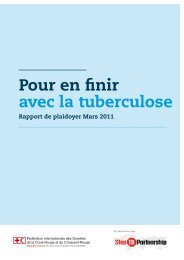Thailand - Stop TB Partnership
Thailand - Stop TB Partnership
Thailand - Stop TB Partnership
Create successful ePaper yourself
Turn your PDF publications into a flip-book with our unique Google optimized e-Paper software.
mortality, and HIV/AIDS are highlighted in current poverty reduction schemes, <strong>TB</strong> is not<br />
mentioned. The government should explicitly acknowledge the linkage between <strong>TB</strong> and poverty<br />
and the significance of <strong>TB</strong> control efforts in all of its policies and programs to prevent<br />
and ameliorate poverty.<br />
DOTS expansion<br />
These are policies that we receive from the government, and from the<br />
international community. . . . [T]hey say that people must receive DOT<br />
in every single case . . . [b]ut . . . we can’t do this 100 percent. . . .<br />
We have a nurse to do home visits. [But n]urses have a lot of duties and<br />
many diseases to take care of—so no, they don’t get to everyone. We try to<br />
utilize community workers. . . . But if the TUC [U.S. Centers for Disease<br />
Control Collaboration] doesn’t provide us with financial support, this won’t<br />
necessarily be sustainable.<br />
—Pruthi Israngkul Na Ayudya, director, Health Center 21, Bangkok 55<br />
Prior to national implementation of the DOTS strategy, supervised <strong>TB</strong> treatment was not<br />
available throughout the country. Though the NTP reported 100 percent DOTS coverage<br />
by 2002, the accessibility and quality of services available varies significantly in practice, as<br />
reflected in variable case detection and treatment success rates among different communities<br />
and regions.<br />
There are indications that the administration of directly observed therapy (DOT)—<br />
an essential component of the DOTS strategy—is not observed strictly in practice. For example,<br />
statistics from the 10th Zonal <strong>TB</strong> and Chest Disease Center in Chiang Mai indicate that<br />
42.1 percent of patients self-administer treatment. 56 Moreover, though DOTS may be available<br />
in all districts, access appears to be difficult for marginalized groups such as migrant<br />
workers and injection drug users. 57<br />
Some Thai experts also indicate doubts about the comprehensiveness and reliability<br />
of reported data on case detection and treatment success. For instance, the reported<br />
71 percent case detection rate may include non-<strong>TB</strong> cases such as bacterial pulmonary infection,<br />
and the national treatment success rate of 73 percent masks rates as low as 25 percent<br />
among some vulnerable groups. 58 Perhaps more importantly, the current targets relate to<br />
detection and treatment of active, sputum smear-positive cases only. The WHO, however,<br />
states that the smear-positive test captures only about 44 percent of all those with active <strong>TB</strong>.<br />
For <strong>Thailand</strong>, this means that despite fairly positive national progress toward meeting the<br />
detection and treatment success targets, in fact only about 23 percent of those with active<br />
<strong>TB</strong> are being cured. 59<br />
PUBLIC HEALTH WATCH MONITORING REPORTS 47



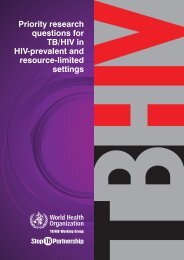
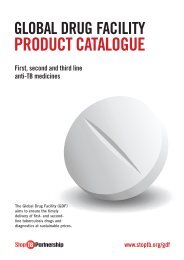
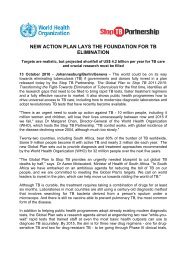
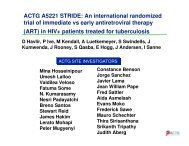
![Global Drug Facility Annual Report 2011 [.pdf] - Stop TB Partnership](https://img.yumpu.com/26788745/1/184x260/global-drug-facility-annual-report-2011-pdf-stop-tb-partnership.jpg?quality=85)

![Concept note on national stop TB partnership [.pdf]](https://img.yumpu.com/26788741/1/184x260/concept-note-on-national-stop-tb-partnership-pdf.jpg?quality=85)
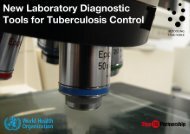

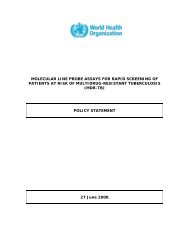
![2005 and Challenges for 2006 - 2015 [.pdf] - Stop TB Partnership](https://img.yumpu.com/26788674/1/190x245/2005-and-challenges-for-2006-2015-pdf-stop-tb-partnership.jpg?quality=85)
![Brochure (French) [.pdf] - Stop TB Partnership](https://img.yumpu.com/17234792/1/190x91/brochure-french-pdf-stop-tb-partnership.jpg?quality=85)

